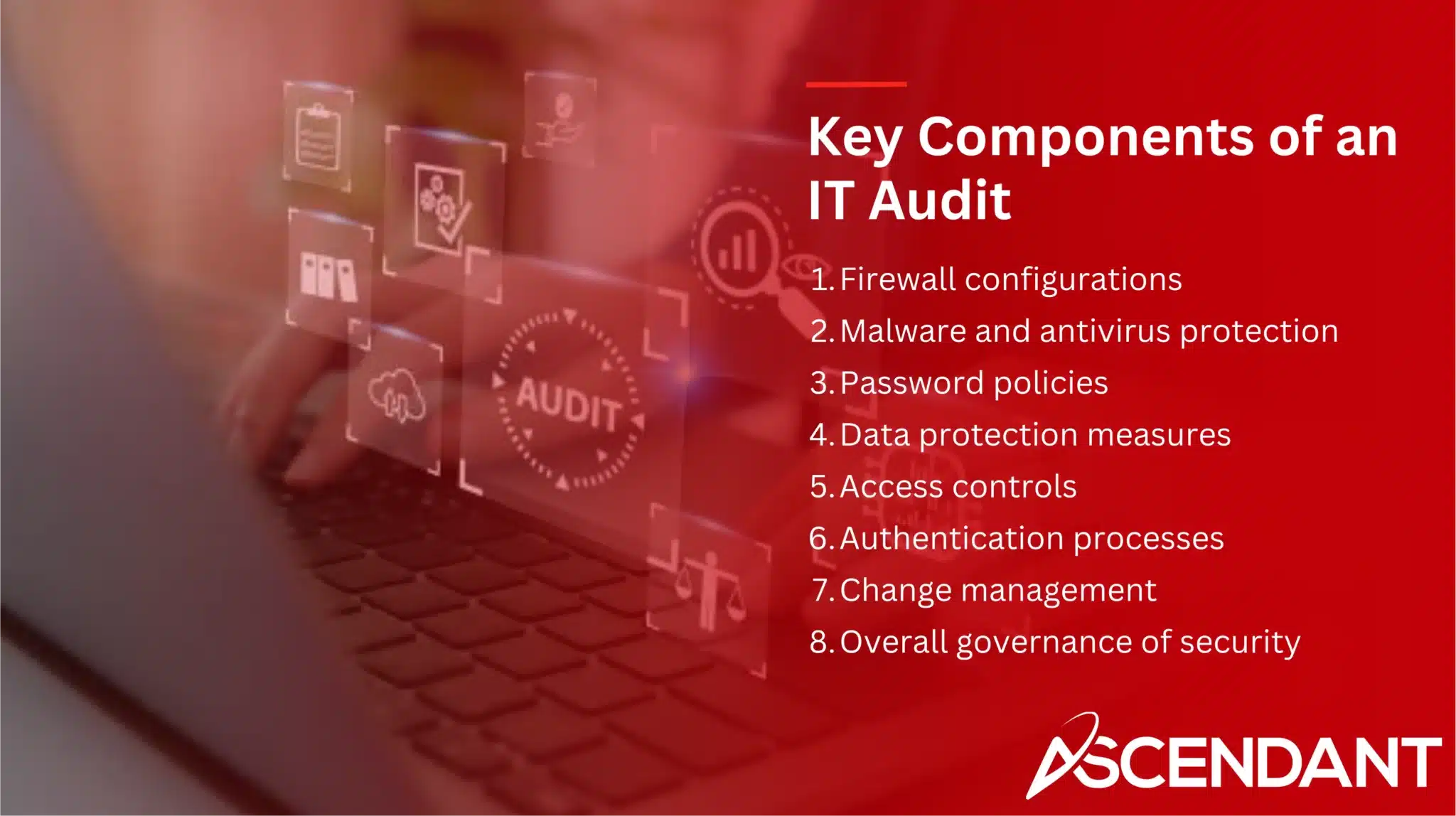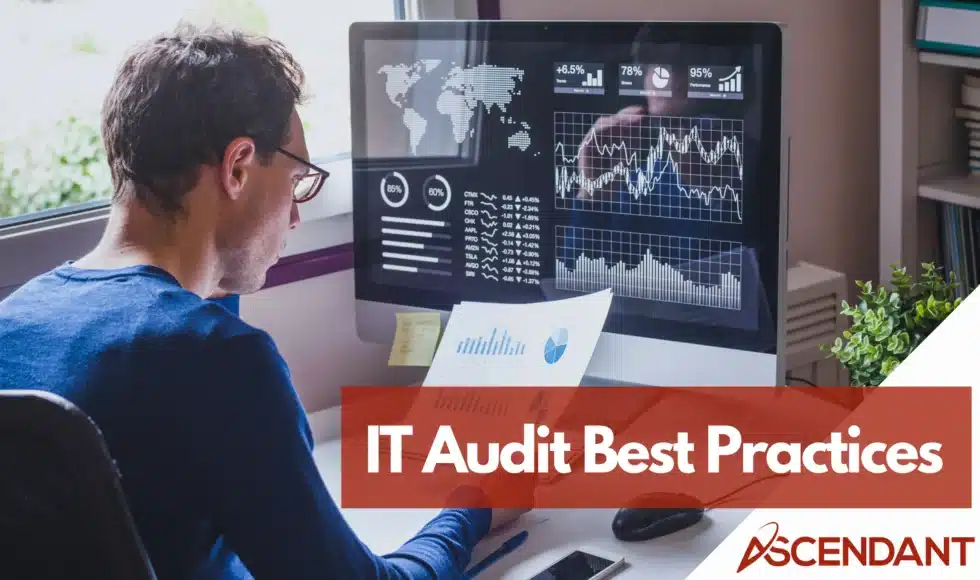An IT audit evaluates your organization’s IT systems for security, efficiency, and regulatory compliance. It’s crucial for identifying vulnerabilities and ensuring data protection. This guide covers everything from understanding what an IT audit entails to the steps involved in conducting one.
Key Takeaways
- IT audits assess the security, compliance, and operational efficiency of information technology systems, focusing on mitigating vulnerabilities and ensuring adherence to regulations.
- The IT audit process involves planning, execution, and reporting, with key components including vulnerability assessments, compliance checks, and risk management evaluations.
- Best practices for successful IT audits include continuous monitoring, comprehensive risk assessments, and leveraging technology such as Computer-Assisted Audit Techniques (CAATs) to enhance efficiency.
Understanding IT Audits
A security audit of IT systems meticulously examines the effectiveness of information technology infrastructures in cybersecurity, data accuracy, and governance. The objective is to verify that these components are functioning with optimal security and to ascertain that employees comply with predefined security protocols. This type of evaluation differs from financial audits as it specifically addresses the performance and safeguarding measures within IT frameworks rather than inspecting monetary records.
Within this framework, IT auditors assume an essential role by conducting thorough inspections across systems and applications to uncover any discrepancies or susceptibilities jeopardizing system integrity. Through what’s known as an IT security audit, organizations can identify shortcomings in their infrastructure while assessing adherence to pertinent regulatory mandates.
The significance of such reviews extends beyond mere validation of safety mechanisms. They’re imperative for aligning with statutory regulations regarding legal compliance. By scrutinizing elements like data protection strategies and conformity assessments pertaining to business support mechanisms during a comprehensive assessment, enterprises reinforce their commitment to fulfilling legislative stipulations alongside preserving high-security benchmarks.
Key Components of an IT Audit
 An IT audit encompasses several critical components that collectively ensure a thorough evaluation of an organization’s IT security posture. A security audit typically covers:
An IT audit encompasses several critical components that collectively ensure a thorough evaluation of an organization’s IT security posture. A security audit typically covers:
- Firewall configurations
- Malware and antivirus protection
- Password policies
- Data protection measures
- Access controls
- Authentication processes
- Change management
- Overall governance of security
These elements form the backbone of a security audit, ensuring comprehensive coverage of all potential security vulnerabilities.
The audit process includes several activities. These activities involve reviewing network architecture, analyzing access controls, testing security protocols, examining compliance with data protection laws, and evaluating cybersecurity measures. This guarantees antivirus software updates across the network and restricted data access for authorized personnel, verified via network activity and event logs.
Additionally, IT audits assess physical security controls within data centers, network security measures, and the effectiveness of internal controls in preventing fraud and unauthorized access to sensitive data. Tailoring assessments to an organization’s specific needs allows auditors to deliver a comprehensive evaluation covering system security, data integrity, risk management, and IT processes.
IT Audit Types and Their Importance
The field of IT audits encompasses a range of types tailored to assess particular elements within an organization’s IT framework. Security audits specifically examine the network systems of an organization, verifying that they comply with security protocols and protect customer data. Such assessments are vital for adhering to legal standards like those outlined in HIPAA and SOX, helping avoid potential liabilities and penalties.
Frequently conducting security audits plays a pivotal role in organizations by pinpointing weaknesses in their security controls, thereby ensuring continuous adherence to certifications such as ISO 27001 and SOC 2. Carrying out an information technology security audit is crucial for upholding strong protective measures against cyber threats.
While operational audits inspect the effectiveness of procedures within the IT sector—aiming at better resource usage and workflow management—the performance type scrutinizes system reliability while guaranteeing peak operational capacity across infrastructure. Likewise critical are business continuity assessments which analyze organizational readiness for recovery after disruptive events. This factor is essential for enduring viability.
Holding regular internal reviews aids in perpetuating solid internal controls—usually performed on an annual basis. The dual practice involving both internal and external examinations affords extra oversight every few years. Confirming compliance aligns businesses with required industry regulations through appropriate procedural actions aligned with standard demands.
The IT Audit Process
The IT audit process entails a methodical strategy aimed at assessing an organization’s cybersecurity infrastructure, focusing on compliance adherence and identifying potential risks. This continual process is initiated much prior to the actual auditing period, requiring thorough planning and a comprehensive grasp of the specific needs pertinent to the organization.
In order to maintain an organized methodology, IT auditors develop programs for audits that include detailed steps and schedules necessary for carrying out these evaluations. The procedure is partitioned into three principal stages: initial planning and groundwork, execution, as well as documenting outcomes—with each stage being essential for achieving success in the overall auditing endeavor.
Planning and Preparation
Commencing an IT audit requires setting the objectives and determining its scope, guided by a comprehensive risk assessment alongside the organization’s unique needs. Ensuring these objectives correspond with both strategic aims of the organization and applicable regulatory demands is critical for alignment. Forming an audit team with diverse skills and viewpoints contributes significantly to enhancing the overall efficacy of the audit.
To effectively comprehend the IT landscape and devise a pertinent auditing strategy, meticulous planning is crucial. It encompasses examining existing policies and procedures, evaluating strategies related to risk management, and confirming that adequate security measures have been implemented to safeguard data integrity while fulfilling compliance obligations.
Execution
In the execution phase of an audit, evaluators employ numerous techniques—including interviews and examination of documents—to evaluate IT controls. This phase includes performing vulnerability assessments that pinpoint potential security shortcomings within the IT infrastructure, including but not limited to firewalls and other protective strategies.
It is vital for auditors to budget ample time during their auditing schedule for unforeseen challenges. Ongoing scrutiny of IT controls throughout this stage is critical in detecting any frailties or instances where compliance does not meet standards, which helps affirm that the organization’s security program remains strong and operative.
Reporting Findings
Documenting and reporting the outcomes is an essential final stage in the IT audit process. The importance of this documentation cannot be overstated, as it serves to delineate risks that have been uncovered during the audit while also pointing towards potential improvements. Conveying these findings with clarity allows management teams to grasp and act upon the issues presented.
It’s imperative for significant hazards to be highlighted within these audit findings, along with suggestions aimed at strengthening IT governance processes. In composing the audit report, incorporating stakeholder input is key to ensuring that it truly represents what was discovered during auditing activities and any strategies recommended going forward. Keeping a clear line of communication open with all stakeholders encourages cooperative efforts which can greatly aid in enacting recommendations derived from the audit.
Selecting Criteria for IT Audits
The selection of appropriate criteria for conducting IT audits is vital to achieve thoroughness and consistency throughout the audit process. The NIST Cybersecurity Framework offers a flexible approach that caters to organizations of various sizes and needs, enabling them to adopt guidelines tailored specifically to their operations. CIS Controls provide actionable and detailed guidance suited for organizations with limited cybersecurity knowledge.
By combining aspects from both the NIST framework and CIS Controls, entities can forge a customized cybersecurity strategy that aligns perfectly with their unique requirements. Compliance audits are carried out to verify adherence to legal and regulatory obligations related to IT practices, while privacy audits meticulously examine compliance with regulations protecting personal and sensitive information.
Employing a risk-based methodology enables auditors to concentrate on areas deemed most critical within the audit’s scope. Establishing explicit objectives ensures that the audit process supports an organization’s strategic intentions effectively. Risk assessments play a key role in pinpointing potential weak spots in IT systems by helping prioritize actions aimed at reducing exposure through focused mitigation tactics—this makes adopting established auditing frameworks essential for comprehensive evaluations.
Role of IT Auditors
In the realm of auditing, IT auditors are critical in conducting a thorough and competent audit process. They bring extensive business acumen, industry insights, as well as an understanding of legislative requirements and outcomes from risk assessments. Certifications like that of a Certified Information Systems Auditor (CISA), alongside credentials such as Certified Information Security Manager (CISM), stand out among their professional qualifications.
These auditors carry out vital tasks that include scrutinizing the IT infrastructure, managing potential risks, maintaining regulatory compliance, recording discrepancies found during audits and recommending actionable strategies for improvement. It is incumbent upon them to review how robustly internal controls function in safeguarding against illicit access to sensitive information while also effectively breaking down intricate technical findings into more digestible formats for organizational management.
For evaluations made by IT auditors to hold weight and remain above reproach, they must embody impartiality along with independence. Hallmarks which lend credibility to their analyses without any question of bias or conflict-of-interest influences. This role can be filled either by internal auditors who offer inside-out perspective or external auditors bringing third-party insight into the audit process—each providing unique value through their distinct perspectives on technological scrutiny within organizations.
Common Challenges in IT Audits
Security audits play a pivotal role in safeguarding data security, yet they come with their own set of challenges. A key difficulty lies in acquiring ample documentation that validates the proper functioning of control measures. Human error can contribute to exposing organizational weaknesses, underscoring the necessity for thorough scrutiny of security training provided to staff within these IT audits as a means to curtail such risks.
To mitigate potential security incidents, many cybersecurity protocols stipulate mandatory basic security education for all employees. Through consistent and proactive execution of regular security audits, organizations can detect vulnerabilities early on—thereby preserving their reputation and bolstering their established data protection practices.
Conducting comprehensive evaluations is indispensable when it comes to pinpointing frailties that may endanger the confidentiality, integrity or availability of data. It’s vital for maintaining effective internal controls aimed at thwarting any breaches in information safety.
Best Practices for Successful IT Audits
In order to carry out IT audits that are successful, it is crucial to adhere to a number of recommended procedures. Maintaining continuous surveillance over the IT landscape allows for adjustment in response to new threats while preserving adequate control strategies. Auditors should pursue continual education so as to remain informed about the latest developments in both IT risks and auditing best practices.
A thorough execution of an IT audit encompasses detailed risk assessments aimed at pinpointing potential hazards and assessing the strength of current safeguards. Applying methods related to data analytics provides auditors with powerful tools for managing and interpreting intricate data during their evaluations. While establishing effective internal controls presents its challenges, they are essential components in guaranteeing both reliability and integrity within systems.
Leveraging Technology in IT Audits
Incorporating technology into the IT audit process notably improves its performance. Tools known as Computer-Assisted Audit Techniques (CAATs) have been developed to streamline auditing by providing automated solutions for data examination, thereby freeing up auditors to concentrate on more intricate assessments.
The inclusion of CAATs within an organization’s audit framework necessitates meticulous choice of appropriate instruments and crafting customized tests specific to the entity’s requirements. Through the application of these sophisticated tools, auditors are able to execute audits that are not only deeper but also faster, thus significantly enhancing the firm’s defensive mechanisms against potential threats.
Summary
To summarize, the necessity of IT audits lies in their role in protecting an organization’s IT systems from potential threats while verifying adherence to regulatory standards and pinpointing security weaknesses. An intimate knowledge of the principal elements, varieties, and methodologies pertinent to IT audits equips organizations with the capacity for comprehensive evaluations.
By implementing industry best practices and incorporating technological tools like Computer Assisted Audit Techniques (CAATs), the efficacy of audit processes can be significantly improved. A solid approach to IT auditing is pivotal for institutions aiming to uphold stringent security protocols, safeguard sensitive data against breaches, and guarantee enduring operational integrity.
 Frequently Asked Questions
Frequently Asked Questions
What is the primary purpose of an IT audit?
The primary purpose of an IT audit is to ensure the security and proper functioning of IT systems while ensuring compliance with established security standards.
This process helps organizations safeguard their data and mitigate risks effectively.
What are the key components of an IT audit?
Essential elements for maintaining the integrity and security of an organization’s information systems include the evaluation of network architecture, testing security protocols, and implementing key IT audit components such as security controls and access controls.
How often should internal and external audits be conducted?
Internal audits should be conducted annually, while external audits are generally performed every few years. This regular schedule ensures compliance and effective risk management.
What certifications are notable for IT auditors?
Notable certifications for IT auditors include the Certified Information Systems Auditor (CISA) and the Certified Information Security Manager (CISM), as they significantly enhance professional credibility and expertise in information systems auditing and security management.
What are some common challenges in IT audits?
IT audits often face challenges such as inadequate documentation, the potential for human error, and the need to evaluate staff training effectively. Addressing these issues is crucial for a successful audit process.

